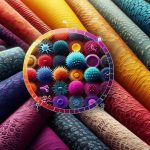Imagine a shield that protects your fabrics from the relentless grip of mildew. When choosing materials for your home or wardrobe, understanding which fabrics naturally resist mildew can make a significant difference. From bamboo’s antimicrobial qualities to hemp’s moisture-wicking structure, these options not only fend off unwanted growth but also enhance comfort and sustainability. Curious about how these fabrics stack up against each other?
Table of Contents
Key Takeaways
- Bamboo fibers possess remarkable antimicrobial properties that inhibit mildew growth and keep fabrics fresher for longer periods.
- Hemp’s unique structure prevents moisture retention, making it resistant to mildew while promoting air circulation for comfort.
- Cotton blends enhanced with natural additives like aloe vera improve mildew resistance and extend the fabric’s lifespan in humid conditions.
- Silk’s hydrophobic nature repels water, preventing mildew formation and keeping the fabric feeling fresh and clean.
- Synthetic fabrics such as polyester and nylon have lower moisture absorption rates, which excel in moisture management and prevent mildew growth.
Bamboo Fibers and Their Antimicrobial Properties
Bamboo fibers stand out for their remarkable antimicrobial properties, making them an excellent choice for fabrics that resist mildew. When you choose bamboo-based textiles, you’re opting for a material that helps inhibit the growth of bacteria and fungi.
This means your clothing and home textiles can stay fresher for longer, reducing odors and the need for frequent washing. Plus, bamboo is naturally breathable, allowing moisture to evaporate quickly, which further deters mildew.
You’ll appreciate how soft and comfortable it feels against your skin, making it perfect for everyday wear. Whether you’re looking for bed linens, towels, or activewear, bamboo fabrics provide a sustainable and effective option to keep mildew at bay while promoting a healthier environment.
Hemp: The Durable and Mildew-Resistant Option
When you’re seeking a fabric that combines durability with natural mildew resistance, hemp is an excellent choice. This remarkable plant-based fiber is known for its strength and resilience, making it ideal for various applications, from clothing to home textiles.
Hemp has a unique structure that inhibits moisture retention, preventing mildew growth effectively. Plus, it’s breathable, allowing air circulation to keep you comfortable.
Caring for hemp is straightforward, as it tends to become softer with each wash while maintaining its integrity. Its natural resistance means you won’t constantly deal with mold or unpleasant odors.
With hemp, you’re not only choosing a long-lasting option, but you’re also supporting sustainable practices, making it a win-win for eco-conscious consumers.
Cotton Blends Enhanced With Natural Additives
When you choose cotton blends enhanced with natural additives, you’re boosting not just comfort but also durability.
These additives provide significant benefits, like improved mildew resistance, making your fabrics last longer and perform better.
Embracing these innovations means you can enjoy the softness of cotton while benefiting from the strength of nature.
Natural Additives Benefits
Cotton blends enhanced with natural additives offer a remarkable solution for those seeking both comfort and durability in their fabrics.
These natural additives, like aloe vera or tea tree oil, bring unique benefits that elevate your experience. Not only do they enhance the softness of the fabric, but they also provide inherent antimicrobial properties, reducing the growth of mildew and odor.
This means your garments stay fresher for longer, even in humid conditions. Plus, they’re often more eco-friendly, allowing you to make a sustainable choice without sacrificing quality.
You’ll enjoy the peace of mind that comes with knowing your clothing is healthier for you and the environment. Embrace the advantages of these innovative blends for your wardrobe.
Enhanced Durability Features
While many fabrics struggle with wear and tear, cotton blends enhanced with natural additives stand out for their impressive durability.
These blends resist fraying, fading, and tears better than standard cotton, allowing you to enjoy your items longer. The natural additives, such as hemp or bamboo, boost strength without sacrificing comfort.
You’ll appreciate how these materials hold up under stress, whether you’re using them for clothing, upholstery, or outdoor gear. Plus, they maintain breathability, ensuring you stay comfortable while benefitting from their long-lasting properties.
Investing in cotton blends with natural additives means you’re choosing a fabric that can withstand the rigors of daily life, providing you with both resilience and peace of mind.
The Hydrophobic Nature of Silk
Silk’s hydrophobic nature makes it a fascinating material in the domain of textiles. This property means that silk repels water, which can help prevent mildew from forming.
When you wear or use silk, you’ll appreciate how its ability to resist moisture keeps it feeling fresh and clean. Unlike many other fabrics, silk doesn’t easily absorb water, allowing it to dry quickly.
This rapid drying helps inhibit the growth of mold and mildew, making silk a suitable choice for various applications, from clothing to upholstery. However, it’s essential to care for silk properly, as its delicate fibers can be damaged by excessive moisture.
Wool’s Resistance to Mildew Under Certain Conditions
When it comes to natural mildew resistance, wool stands out for its unique properties that help it fend off mold under specific conditions.
Its structure allows wool to absorb moisture without feeling wet, which is vital because mildew thrives in damp environments. If you keep wool dry and well-ventilated, it can resist mildew effectively.
Additionally, the natural oils present in wool create an unfavorable environment for mold growth. However, if wool gets saturated or stays damp for extended periods, it may become susceptible to mildew.
To maximize wool’s resistance, wash it gently and avoid prolonged exposure to humidity. By understanding these factors, you can enjoy the benefits of wool while minimizing the risk of mold.
Synthetic Fabrics and Their Lower Moisture Absorption
Although synthetic fabrics often lack the natural properties of wool, they excel in moisture management due to their lower moisture absorption rates.
Fabrics like polyester and nylon repel water, allowing sweat to evaporate quickly instead of soaking into the material. This feature makes them ideal for activewear and outdoor gear, where you need to stay dry during intense activities.
Their quick-drying nature helps prevent mildew growth, reducing odors and prolonging the life of your garments. Plus, since these fabrics don’t absorb moisture as much, they’re less likely to develop those pesky mold spots.
Hybrid Fabrics: A Balanced Approach to Mildew Resistance
As you explore options for mildew resistance, hybrid fabrics offer a compelling solution that combines the best features of both natural and synthetic materials.
These fabrics often blend the moisture-wicking properties of synthetics with the breathability and comfort of natural fibers. This combination not only helps in reducing mildew growth but also enhances durability and performance.
You’ll find that hybrid fabrics can handle humidity better than pure natural fabrics while remaining more eco-friendly than traditional synthetics.
Whether you’re considering outdoor gear, upholstery, or activewear, these materials can provide a balanced approach to mildew resistance.
Effective Fabric Finishes and Treatments
When choosing fabrics, you’ll want to contemplate finishes that enhance mildew resistance.
Mildew-resistant coatings can provide an extra layer of protection, while antimicrobial fabric treatments help keep your textiles fresh.
Both options play an essential role in extending the life and usability of your fabrics.
Mildew-Resistant Coatings
While many fabrics are susceptible to mildew, applying mildew-resistant coatings can greatly enhance their durability and longevity.
These coatings create a protective barrier, making it harder for mildew spores to take hold.
When selecting a mildew-resistant coating, consider the following benefits:
- Increased lifespan: Coatings help fabrics withstand moisture, extending their usability.
- Easy maintenance: Fabrics treated with these coatings often require less frequent washing.
- Versatile application: You can use these coatings on various materials, from cotton to synthetic blends.
- Environmental protection: Many coatings are eco-friendly, reducing harmful chemical exposure.
- Cost-effective: Investing in these treatments can save you money by preventing fabric deterioration.
Antimicrobial Fabric Treatments
Building on the idea of enhancing fabric durability, antimicrobial fabric treatments offer another layer of protection against unwanted microbes, including bacteria and fungi.
These treatments can be applied to various fabrics, making them ideal for items like clothing, bed linens, and upholstery. By actively inhibiting microbial growth, they help maintain freshness and extend the lifespan of your textiles.
You’ll find treatments that use natural substances, like silver ions or essential oils, alongside synthetic options that provide robust protection.
When selecting antimicrobial fabrics, consider how they’ll be used and their care requirements. Regular washing can help maintain their effectiveness, ensuring that your treated fabrics stay clean and safe from mildew and odor.
Preventive Measures for Maintaining Mildew Resistance
To effectively maintain the mildew resistance of your fabrics, it’s crucial to implement several preventive measures.
By taking these steps, you’ll help guarantee your materials stay fresh and free from mold.
- Store fabrics in a cool, dry place to reduce moisture buildup.
- Regularly clean your fabrics according to care instructions, as dirt and grime can promote mildew growth.
- Use breathable storage bags or containers to allow airflow.
- Avoid leaving damp items in enclosed spaces for extended periods.
- Consider using natural moisture absorbers, like silica gel or activated charcoal, to keep humidity levels low.
Frequently Asked Questions
How Can I Improve Mildew Resistance in My Existing Fabrics?
To improve mildew resistance in your existing fabrics, you can wash them regularly, dry them in sunlight, and consider applying a mildew-resistant spray. Keeping them dry and properly ventilated helps prevent growth in the first place.
What Are the Signs of Mildew on Fabrics?
Did you know that about 25% of fabrics can harbor mildew? You’ll notice signs like a musty smell, discoloration, and fuzzy spots. If you see these, it’s time to take action against mildew.
Can I Wash Mildew-Resistant Fabrics in Hot Water?
You can wash mildew-resistant fabrics in hot water, but it’s best to check the care label first. Hot water can help eliminate bacteria, but it might also affect certain fabric types. Always follow specific instructions.
Is Mildew Resistance Permanent or Does It Wear Off?
You might think your favorite shirt’s mildew resistance is forever, but it doesn’t last indefinitely. With regular use and washing, it can wear off, so keep an eye on its condition to maintain freshness.
How Does Storage Temperature Affect Mildew Growth on Fabrics?
Storage temperature plays an essential role in mildew growth on fabrics. If you keep your fabrics in warm, humid conditions, you’re likely to see increased mildew. Cooler, drier environments help inhibit its development considerably.
- What Is Pochampally Ikat? a Journey to India’s Silk City - June 27, 2025
- What Is Pochampally Ikat? a Journey to India’s Silk City - June 27, 2025
- What Is Pochampally Ikat? a Journey to India’s Silk City - June 27, 2025







